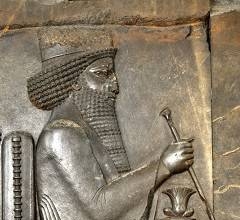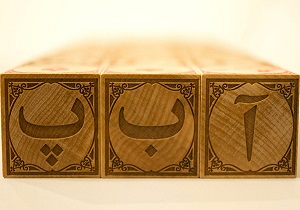Full description of Rostam role

At the bottom of the mountain Very beautiful sculptures from the Sassanid era Which are, in order from right to left
– Narsi's coronation (294-304 ad) The son of Shapur I Sasanian who received the Shahriari ring from Anahita, the water god (Shapur Dekhtak, Narsi's wife) receives.
– The second scroll, which is located under the tomb of Darius the Great, contains two scrolls that show the victory of Bahram II (273-294 ad) It is on its enemy.
– The third role, which is the most beautiful, luxurious and proud role of the Sassanid period, shows the glory and greatness of Shapur I. (239-270 ad) He is the king of Iran before whom the Roman emperor Valerian kneeled in submission
– The fourth character indicates the victory of Hormuz II (302-309 ad) on his enemy. On top of this pattern, other sculptural works can be seen
– The fifth role is probably the image of Shapur II (309-379 ad) is
– The sixth role, which is related to the time of the Elamites (700 Before Christ) and the role of Bahram II (274-294 ad) along with relatives and friends, it is carved on the Elamite scroll. On both sides of Naqsh Bahram, traces of Elamite carvings can still be seen
– The last role belongs to the coronation of Ardeshir Babakan (224-239 ad) He is the first Sassanid king to receive the Shahriari ring from Ahura Mazda
…
Among other works in Naqsh Rostam, there is a balanced and stable stone building called Zoroaster's Kaaba, which is considered one of the most important unique works of the Achaemenid era.. There are different opinions about this building
Other works such as a water well and two stone hearths from the Sasanian era can be seen in Naqsh Rostam
—
The first role
This large unpaved space that is visible may have been prepared for the purpose of paving the historical events of the late Sassanid period, but the opportunity to finish it was not obtained.. The length of this assembly 10 meters and its height 5 meters and approx 2 meter from the surface of the ground, in the center of this unpaved part, there is a twenty-line inscription in Persian, which is very new, and it is a dedication letter related to "Muhammad Rafi Khan, Ibn Al Khan Al-Azeem".. It should be noted that this inscription is mentioned in many references and even on the guide board next to the work as "Dividing water consumption for cultivated lands next to Naqsh Rostam".
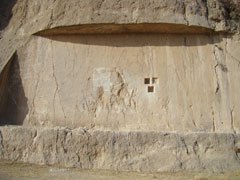
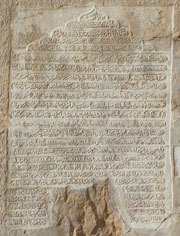
—
The second role
Narsi's coronation 294-304 ad
Narsi, the son of Shapur I and the ruler of Armenia in 294 AD on Bahram III, son of Bahram II and grandson of Bahram I (That is, his nephew's son) He rebelled and won the throne of Iran. This very famous rock carving shows the coronation of Narsi. There is a royal ring between him and a crowned woman, and it is like Narasi taking it from the lady's hand.. The said lady is standing to the right, her curly hair is arranged in a crown of congress, and her long, hanging dress is fastened with a belt and fastened with a button on her breast, and under a jeweled necklace.
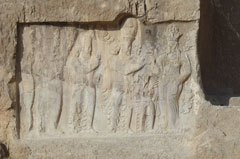
—
The third role
Victory of Bahram II (274-294 ad) He shows it to his two enemies. This role is carved in two scenes, one above the other, separated by a thin line. Bahram, riding a four-hooved horse, gallops towards an enemy rider and hits him with his long spear in such a way that the enemy's spear is broken.. Behind Bahram's head, a decorated rider is holding a shield, which has a horizontal bar decorated with three spheres on top of it, and two pieces of cloth are hanging from it.. Maybe this is the same door that the Roman historian Ammianus says the Sassanians raised during the attack and its color was red like a flame.
One of the beauties of this painting is the horse's cloth covering with tassels and its decorated mouth and bridle, and the other is the long pole that hangs on the right thigh of the king.. In this scene, the role of a Roman soldier who fell to the ground and was trampled by Bahram's horse was also carved.
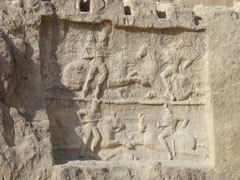
—
The fourth role
Victory of Shapur I
Victory of Shapur I (239-270 ad) It shows Roman Emperor Valerian. During the time of Shapur I, three Roman kings invaded Iran. One was a young "Gordianus" who 242 Miladi was killed. The other one was "Philip the Arab" who was forced to fail against Shapur and agreed to pay an annual ransom and the third was "Valerin" who 262 Miladi was captured by Iranians with seventy thousand Roman soldiers, emirs and senators. Shapur described his victory on the wall of Zoroastrian Kaaba in Naqsh Rostam
Shapur says in this inscription:
Valerian with an army that includes 29 The group was European (He names them one by one) And it reached seventy thousand people and came to our war. A great war broke out between us and Emperor Valerian around Ella and Edesa. We captured Emperor Valerian with our own hands and transferred them all to the Persian states
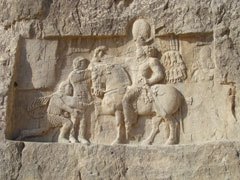
This scene of Shapur's victory is one of the most beautiful historical reliefs of Naqsh Rostam and tells about an incident that is a source of pride for Iranians.. Shapur is depicted with a congressional crown and an ornate robe on a horse facing left, with Philip the Arab, the Roman tax collector, kneeling in front of him. (This emperor is not unlike Valerian's imagination). The king extended his hand to him to show his acceptance of his ransom. Philip is wearing a Roman crown and his top is fluttering on his shoulders, as you said, he hastened to kneel before the king of Iran..
He has stretched both his hands forward in a gesture of forgiveness. The greatness of the king from his clothes, his ornaments (Necklace, bracelet and tiara) And the style of his folded hair and falling on his shoulder, as well as the mouth, saddle and bridle of his proud horse, all show greatness.
Next to Shapur, another Roman emperor is standing, and Shapur is holding his wrist as a sign of his capture, and this is the captured emperor of Valerian.. It seems that the people in this role are completely alive and this confirms the skill and mastery of the artists of the Sassanid period.. Behind the head of the king's horse is the image of the great Mobad "Cartier" who is wearing an oval hat decorated with a scissor symbol, and the index finger of his right hand is extended to Shapur as a sign of respect, and he is wearing a necklace decorated with pearls. And the top is fastened with a pin in front of the shoe chest
—
The fifth role
Tomb of Ardeshir I
Under the tomb of Ardeshir I, a sculptural assembly with two figures can be seen. The top role goes to Azar Narse or Shapur Dzolaktaf (310-379 ad). This role has almost completely disappeared. The lower part belongs to Hormuz II 302-310 ad
Hormuz II is the grandson of Shapur I Sasanian. This painting shows the scene of Hormuz's victory over his enemy. The four-hoofed king has ridden the enemy and has knocked down the enemy's horse. The Roman enemy has a beard that has been cut at the bottom, and his helmet has a crown-like decoration like the Romans themselves
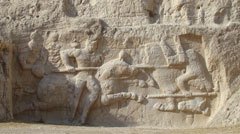
A long spear can be seen next to the king's right leg. The king's horse is interestingly decorated with woolen ornaments and tassels on the horse's thigh. The tail is tied as if and the horse is decorated with bridle and glitter. Behind the king's head, the banner can be seen
—
The sixth role
under Tomb of Darius II And on the Zoroastrian Kaaba, a carved figure from the Sassanid period attracts the attention of the viewers.. The length of this role 7.6 And its height 3 meters. In this role, a crowned rider has thrust his spear into the enemy's neck. The date and character of this conqueror is unknown, but according to some scholars, this role belongs to Shapur II (309-379 ad) is confirmed by the assumption that his crown is similar to Shapur's crown on his coins. The enemy's spear is broken and his horse falls on the ground
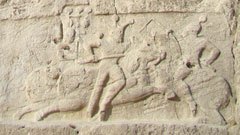
—
The eighth work
The role of Bahram II and his family which is carved on an old Elamite sculpture. This part of the mountain had a carving from the beginning of the first millennium BC and belonged to the Elamite rulers, which was later severely damaged by the creation of Bahram II's carving, but two parts of this carving are still left.: One on the right, which shows a man in a long dress and a sharp-brimmed hat, and the other on the left, which shows a goddess on a throne of snakes.. The complete example of this type of sculptures has been left in Mamsani Korangon, and from the remaining examples, it is possible to recognize the original form of this missing figure.
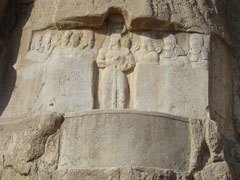

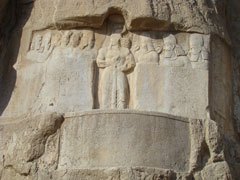
Bahram II Sassanid (274-294 ad) He erased a part of Elami's image and instead carved a shrine that shows himself standing among his friends and family members.. The king's crown is decorated with an eagle, which is the special bird of Bahram, the god of victory. The king is wearing a very ornate dress and is holding a long sword with both hands as a sign of power
Water reservoir
This water well or water tank is dug in the form of an irregular pentagon at the foot of the mountain, the longest side of which is 720 cm and the rest of its sides 550 It is cm long. Perhaps due to the sanctity of the area, especially during the Sassanid era, a water reservoir was necessary for the visitors who came to visit the monuments or for their horses.
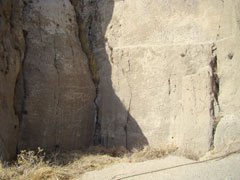
—
Zoroastrian Kaaba
This very beautiful and cube-shaped building in front of the mountain, which attracts the attention of the viewers, has been called "Zoroastrian Kaaba" in the last two centuries because they thought that it was related to the Zoroastrian religion of the ancient Iranian prophet.. The skill and precision used in cutting and sculpting the massive white and black stones of this building shows the mastery of the artists and the architectural style of the Achaemenid period.. This building was badly damaged by uninformed invaders, but at the same time it is considered as one of the most important historical monuments of Iran.. The lower part of the building is solid, but on top of the building there is a room of the same size 2.5 * 2.5 There is a meter, the use of which has become the subject of much discussion. Some consider it to be a fire temple, and its location and its impenetrability largely reject this hypothesis.

A group considers it to be the place where the documents are kept or even where the embalmed bodies of the kings were kept before their tombs were built.. But the hard staircase of this building and its narrow place reject this hypothesis to a large extent. The best interpretation is that this building was built for a tomb, but then when Darius the Great changed the type of royal tomb from a building to a tomb inside the mountain, this building was also used for another purpose.. A thirty-step staircase was built for this building, the upper part of which was destroyed by some ignorant people throughout history.
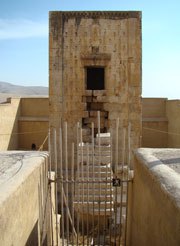
The long inscription engraved around the lower wall of this building is one of the first Sassanid shapur, written in three Sasanian Pahlavi languages. (Middle Persian), Parthian and Greek Pahlavi has been hacked and its main topic is the description of the historical events of the era of Shapur I, especially the war between Iran and Rome, in which the war of three Roman emperors named "Gordianus", "Philip the Arab" and "Valerian" was barely defeated. They ate and the latter was imprisoned in Bishapur after being captured 262 ad
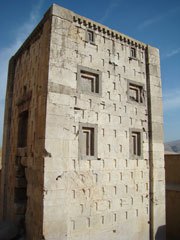
Another inscription is below the first inscription, which is written in Parthian Pahlavi language 19 The line was engraved by "Cartier" Mobad Mobadan. While introducing himself and his titles, "Cartier" describes the services he has done in this path of Zoroastrian religion and his reaching the position of the great and noble Mobad. (Judge) The whole country and the guardianship of the Anahita temple speak

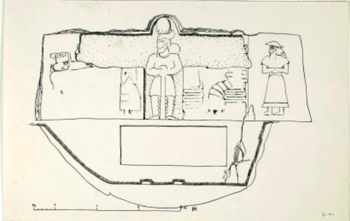
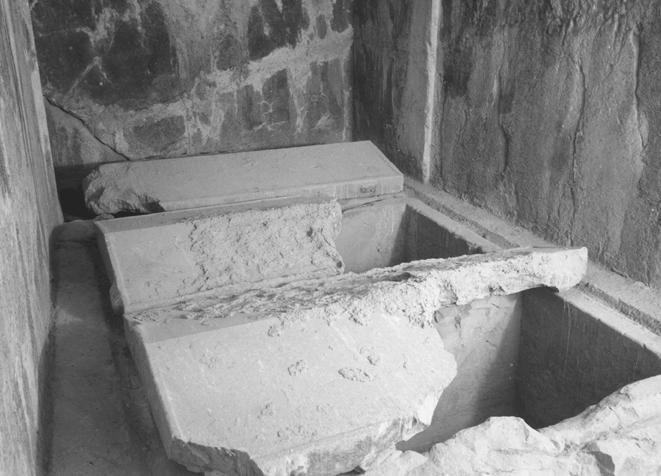
References:
they have owners
wikipedia (dot) org
farsnegar (dot) and
Career of Ardeshir Babakan, Bahram Farehvashi
Illustrated description of Persepolis, Shapoor Shahbazi
Pahlavi language, Jale Amoozgar and Ahmad Tafzali
Artawiraf Nameh, by the efforts of Dr. Rahim Afifi
Inscriptions of ancient Iran, Mohammad Taghi Rashid, a student
Dariush Bozor, Reza Shabani
Ancient Iran, Nader Mir Saidi



